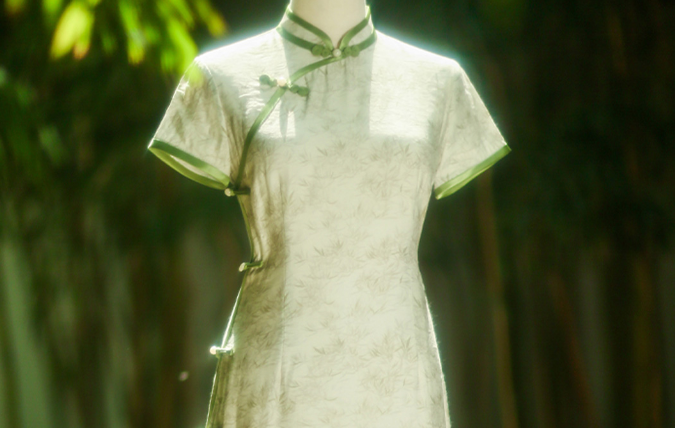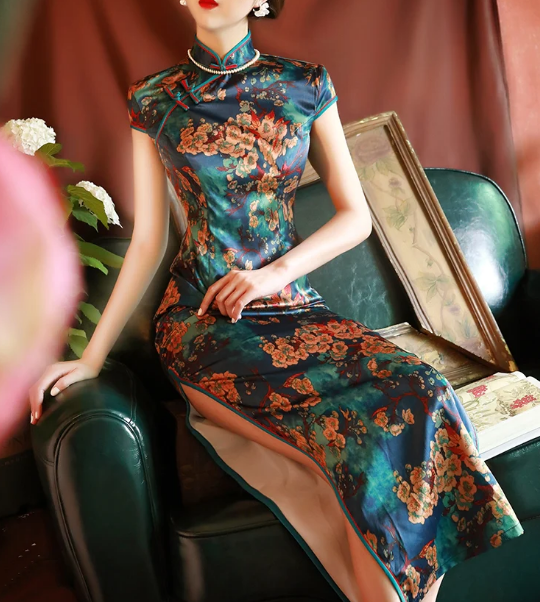The Origins of Cheongsam
The cheongsam, or “qipao” as known in Mandarin, emerged as a fusion of traditional Manchu female clothing and Western styles. Its roots trace back to the 17th century, when the Manchu ruled China and introduced the “qipao” as part of their culture. The original garment was loose, covering most of the woman’s body, reflecting social norms of modesty.
Ancient Chinese Dress Customs
Before the cheongsam, Chinese women wore a variety of garments such as cross-collared robes and wide-sleeved shirts, with fabrics ranging from silk to cotton, based on the wearer’s socioeconomic status. Notably, during the Han dynasty, a tight-fitting blouse and a flowing skirt defined women’s attire, emphasizing simplicity and elegance.

The Transition to Modern Cheongsam
In the early 20th century, Shanghai became the fashion hub for the cheongsam, where local tailors experimented with silk, brocade, and other high-quality materials to craft form-fitting versions. By the 1920s, the cheongsam had transformed, featuring a high-neck, snug waist, and slits on either side for movement — a dramatic shift from the original loose style. This evolution mirrored China’s openness to modernization and the influence of foreign cultures, especially in cosmopolitan areas.
Cheongsam Through the Dynasties
Cheongsam, as a garment, witnessed various modifications aligning with the aesthetic and social norms of each Chinese dynasty. It began as a functional garment under the Ming Dynasty and evolved into a symbol of feminine beauty in the Qing Dynasty.
The Ming Dynasty Influence
During the Ming Dynasty (1368-1644), women’s clothing emphasized a wide waist and full sleeves, often complemented by a flowing skirt. The style prioritized comfort and ease of movement. Silk was the preferred material for the wealthy, denoting their status, while commoners often wore garments made of hemp or cotton.
The Qing Dynasty and Cheongsam Evolution
With the Qing Dynasty’s (1644-1912) rise, the Manchurian influence reshaped the cheongsam. It adopted a straighter cut, side slits, and a high neck, signifying modesty and sophistication. The use of intricate patterns and vibrant colors reflected the wearer’s rank and wealth. During this era, the cheongsam evolved significantly, becoming tighter and more form-fitting, a change that highlighted the feminine silhouette.
The Cheongsam in the 20th Century
The 20th century marked a period of unprecedented change for the cheongsam, turning it into a symbol of Chinese identity and femininity. It mirrored the nation’s journey through cultural shifts, wars, and revolutions.
Early 1900s: The Cheongsam Renaissance
In the 1920s and 1930s, the cheongsam entered a renaissance in Shanghai, becoming the fashion choice for upper-class women and socialites. Tailors used luxurious materials like silk and satin, integrating Western tailoring techniques to enhance the fit. This era saw the hemlines rise and the introduction of high-end embellishments, as the cheongsam became a canvas for expressing personal wealth and modernity.
Mid-Century: Political Changes and Fashion
During the mid-20th century, China’s political landscape underwent significant transformations, affecting fashion trends and manufacturing. The establishment of the People’s Republic in 1949 saw the cheongsam’s popularity decline as it became associated with bourgeois decadence. However, in Hong Kong and Taiwan, the cheongsam remained popular, maintaining its status as a formal dress option for important social events and gatherings.
Cheongsam as a Cultural Symbol
The cheongsam stands as a poignant emblem of China’s cultural heritage, transcending its origins to become a global icon of elegance. It reflects the intricate blend of China’s past and the progressive strides of its women through changing times.
The Cheongsam in Chinese Literature and Cinema
In the realm of literature, the cheongsam takes on a narrative role, often symbolizing the resilience and grace of its wearers amidst societal upheavals. On the silver screen, this garment has been a staple in the visual storytelling of China’s cinematic history. It’s not just a dress; it’s a character, weaving stories of love, loss, and the pursuit of freedom. The cheongsam-clad heroines of the 1930s and 1940s cinema era, like those in the works of Eileen Chang, embodied modernity and the evolving roles of women.
Global Perception of the Cheongsam
On the global stage, the cheongsam represents the allure of Chinese culture, often seen at diplomatic events, fashion runways, and international film festivals. It has inspired countless international fashion designers, who have reimagined its silhouette in various forms, thus continually renewing its image. The cheongsam’s timeless appeal lies in its ability to balance traditional motifs with contemporary fashion sensibilities, making it as relevant today as it was a century ago.
The Craftsmanship of Cheongsam
The artistry behind the cheongsam speaks volumes about the meticulous nature of traditional Chinese tailoring. Every stitch and fold is a testament to the tailor’s skill and the wearer’s taste.
Traditional Techniques in Cheongsam Making
Mastering the cheongsam requires years of dedication. Tailors hand-sew each piece, ensuring precision down to the millimeter. They employ techniques passed down through generations, like the fine art of ‘blind stitching’ – a technique that hides stitches from view to create a seamless appearance. The material selection is equally precise, with silk being a favorite for its quality and luxurious feel.

Innovations and Modern Fabric Use
As technology advances, so does the cheongsam. Modern tailors have introduced new fabrics like stretch cotton and synthetic blends, offering comfort without sacrificing the traditional aesthetic. They balance time-honored styles with modern demands for versatility and durability, ensuring the cheongsam’s place in contemporary fashion.
The Revival of Cheongsam in Modern Times
The cheongsam has experienced a renaissance, reclaiming its status as a symbol of Chinese cultural pride and timeless fashion.
Cheongsam on the Global Fashion Stage
Today, the cheongsam graces international runways, showcasing its blend of traditional elegance with modern flair. Fashion designers frequently celebrate its form, integrating current trends while respecting its heritage. The cheongsam’s silhouette, fabric, and patterns now vary widely, offering wearers around the world a taste of Chinese tradition fused with contemporary style.
Contemporary Cheongsam Designers and Trends
Innovative designers are redefining the cheongsam, using sustainable materials and integrating cutting-edge designs that cater to a diverse clientele. They focus on versatility, with some cheongsams being adaptable for both formal and casual occasions. The designs feature a range of sizes and styles, reflecting the inclusivity and adaptability of modern fashion trends.







